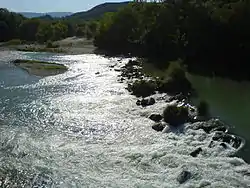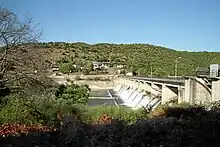| Thyamis | |
|---|---|
 | |
| Location | |
| Country | Greece |
| Physical characteristics | |
| Mouth | |
• location | Ionian Sea |
• coordinates | 39°35′12″N 20°8′32″E / 39.58667°N 20.14222°E |
| Length | 115 km (71 mi) |
| Basin size | about 1,800 km2 (690 sq mi) |
The Thyamis (Greek: Θύαμις), also known as Glykys (Γλυκύς)[1] or Kalamas (Καλαμάς),[2][3] is a river in the Epirus region of Greece. It flows into the Ionian Sea. It is 115 km (71 mi) long,[4][3] and its drainage area is about 1,800 km2 (690 sq mi), over 99% of which on Greek territory.[3] The names of the Chameria region (Tsamouria in Greek), as well as the Chams, derive from the river's name.
Thyamis in ancient Greece was mentioned by Pausanias[5] as forming the boundary between Thesprotis and Kestrine.[6][7] In addition, Suda[8] and Ptolemaeus[9] mentioned it.
Some Renaissance scholars believed that the English River Thames owed its name to the River Thyamis, as early Celtic tribes were thought to have migrated from the Epirus region to England. While this belief influenced the modern spelling of the English river's name, it is no longer regarded as credible.
Geography

The source of the river is near the village Kalpaki, in the northwestern part of the Ioannina regional unit. It flows south at first, and turns southwest near Soulopoulo. It receives its tributary Tyria near Vrosina, and turns west near Kyparisso in Thesprotia, where the hydroelectric dam is located. It empties into the Ionian Sea near the village Kestrini, between Igoumenitsa and Sagiada, close to the Albanian border.
Places along the river include, from source to mouth: Mazaraki, Soulopoulo, Vrosina, Raveni, Pente Ekklisies, Kyparisso, Parapotamos and Kestrini.
During the interwar period of the 20th century, Albanian speaking villages of the Thyamis delta and river basin were small and scattered compared to the upland larger Greek villages of the hilly area to the north.[10]
Environment
Thyamis forms a river delta where it empties in the Ionian Sea, north of Igoumenitsa. The delta is known for being rich in flora and migrating birds stop in its waters for food and rest.
The river, however, has suffered from environmental degradation for decades, due to uncontrolled human activities (farming activity, urban and industrial effluents and waste, lack of management plan and poor coordination of competent authorities for its protection).
See also
References
- ↑ Strabo. Geography, 7.7. Note #35: "The Thyamus, or Thyamis, is now called Glycys, and the Acheron, Calamas."
- ↑ Peck, Harry Thurston. Harpers Dictionary of Classical Antiquities, 1898, p. 1579. "(Thuamis). Now Kalama; a river in Epirus, forming the boundary between Thesprotia and the district of Cestryna."
- 1 2 3 "Preliminary Flood Risk Assessment" (in Greek). Ministry of Environment, Energy and Climate Change. p. 54. Archived from the original on 15 February 2020.
- ↑ Greece in Figures January - March 2018, p. 12
- ↑ Pausanias. Description of Greece, Attica, 1.11.2. "Helenus on his death passed on the kingdom to Molossus, son of Pyrrhus, so that Cestrinus with volunteers from the Epeirots took possession of the region beyond the river Thyamis, while Pergamus crossed into Asia and killed Areius..."
- ↑ Finley, M. I. The Portable Greek Historians: The Essence of Herodotus, Thucydides, Xenophon, Polybius. Viking Portable Library, 1977, p. 220: "There also the river Thyamis flows, forming the boundary between Thesprotis and Kes-trine..."
- ↑ Pliny the Elder. Natural History, 4.1.2, "the Thyamis, a river of Thesprotia..."
- ↑ Suda Encyclopedia, §th.529
- ↑ Ptolemaeus, Geography, §3.13.2
- ↑ Hammond, Nicholas Geoffrey Lemprière (1967). Epirus: the Geography, the Ancient Remains, the History and Topography of Epirus and Adjacent Areas. Oxford: Clarendon Press. pp. 89–90. ISBN 9780198142539. "The greater part of the canton of Filiates lies north of the lower Kalamas. It is contained between the river and its northern watershed, along which the present frontier runs between Greece and Albania. There is little fertile land except in the delta and the inner basin of the Kalamas. The northern part of the canton is broken up by a tangle of mountain peaks, and i found it difficult to traverse.... In contrast to the Albanian-speaking villages of the Kalamas delta and basin, these villages are Greek in speech and outlook,.... The other villages have on average some 200 houses, and they are considerably larger than the scattered Albanian-speaking villages of the Kalamas basin."